It’s a jungle out there
Disorder and confusion everywhere
No one seems to care
Well I do
Hey, who’s in charge here?
It’s a jungle out there
Poison in the very air we breathe
Do you know what’s in the water that you drink?
Well I do, and it’s amazing
People think I’m crazy, ’cause I worry all the time
If you paid attention, you’d be worried too
You better pay attention
Or this world we love so much might just kill you
I could be wrong now, but I don’t think so!
‘Cause it’s a jungle out there ( Randy Newman )
“There were times when I was way out there, hundreds of miles from anything approaching the modern world, with no familiar cultural referent to cling to except Bates. Shuddering with loneliness, I would recall that Bates spent eleven years in Amazonia, yet only once in his narrative is there a suggestion of the discomfort and homesickness that must at times have been unbearable. This uncharacteristically personal momentone of the memorable passages in exploration literature-comes after the first of four and a half years he eventually spent in the village of Ega, fourteen hundred miles up the river….”
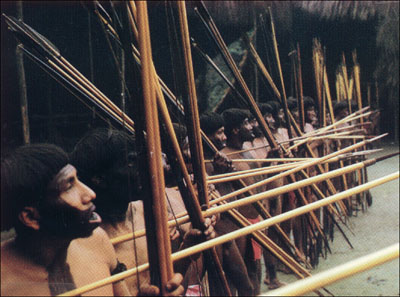
Listen to Claudio Villas Boas (as quoted in Adrian Cowell's 'The tribe that hides from man') about the psychological, and not the material, need that isolated indians in the Amazon feel to make contact with white intruders: As long as we are here, we are calling to them. in the emptiness of the jungle, our human nature is a magnet to theirs. In this way, human groups have always been drawn to other groups, till after thousands of years the whole of mankind now lives in a world civilization. It's only those which are dominated by an extreme fear that remain outside and this is the sort of fear that thrives in the emptiness of the jungle. If people say that every month in the jungle shows its strain on me, them how much more on the Kreen-Akrore, who've been alone for hundreds of years? We must be patient and continue calling to them. Somewhere they are watching us and calling to us.
The world’s worst animals? Not in my backyard? We may regard the malevolent wildlife of the Amazon as both biological miracle and pestilential horror. However, these malevolent animals are more likely to regard us as merely a square meal. Is the Amazon a seeming metaphor for what we perceive as our own chaotic world?
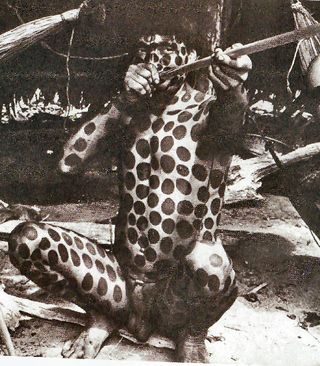
Bates:I found the natives generally as much at a loss in this respect as myself. Sometimes a sound is heard like the clang of an iron bar against a hard, hollow tree, or a piercing cry rends the air; these are not repeated, and the succeeding silence tends to heighten the unpleasant impression which they make on the mind. With the native it is always the Curupira, the wild man or spirit of the forest, which produces all noises they are unable to explain. For myths are the rude theories which mankind, in the infancy of knowledge, invent to explain natural phenomena. The Curupira is a mysterious being, whose attributes are uncertain, for they vary according to locality. Sometimes he is described as a kind of orang-otang, being covered with long shaggy hair, and living in trees. At others he is said to have cloven feet and a bright red face. He has a wife and children, and sometimes comes down to the rocas to steal the mandioca.
Another dangerous fish found by Teddy Roosevelt on his 1914 expedition to the Amazon was the piraiba, or catfish. The one he caught, which was three and a half feet long, had the semidigested remains of a monkey in its stomach. The Brazilians with him swore that around the mouth of the Madeira the piraiba grew far larger and would even prey on men. The expedition’s doctor had seen a monstrous piraiba that had lunged over the side of a canoe at two men and had been defeated only by their machetes. Colonel Rondon told him that on the lower Madeira villagers built stockades in which to bathe, for fear of the piraiba and the alligator. Of the two the former was the most dreaded, since its habit was to lie invisible on the bottom of the river until the moment came to pounce.
…There had been no parcels from England since his arrival at Ega, his clothing was worn to rags, he was barefoot (“a great inconvenience in tropical forests,” he reports, “notwithstanding statements to the contrary that have been published by travellers”), he had been robbed, and his servant had run off. But the worst of it was that there was nothing left to read. He had read from beginning to end even the advertisements of his few precious copies of the Athenaeum. “I was obliged, at last,” he writes, with marvellous understatement, “to come to the conclusion that the contemplation of Nature alone is not sufficient to fill the human heart and mind.”…

"Elena Valero, a Brazilian woman was kidnapped by Yanomamo warriors when she was eleven years old at a time when intertribal warfare and raiding for women was still endemic. No sooner was she kidnapped than Elena Valero's captors were themselves attacked by rival Yanomamo. Again she was taken captive and handed over to one of her abductors as a wife. She would spend the next twenty years among the Karawetari, marry twice with different captors and bear three children before finally escaping. She would witness, and hear about, many more raids. But none were so horrifying as the second one: 'They killed so many. I was weeping for fear and for pity but there was nothing I could do. They snatched the children from their mothers to kill them, while the others held the mothers tightly by the arms and wrists as they stood up in a line. All the women wept'. They fled before the raiders, taking their children with them. 'The men began to kill the children; little ones, bigger ones, they killed many of them. They tried to run away, but..."
The Madeira river has little to recommend it, even if oner disregards the presence of the giant piraiba. Its waters are clotted with silt and mud; its banks, abominably hot, are a haven for malarial mosquitos. In addition, some of its tributaries harbor one other notable pest, the candiru. A thin fish, seldom more than two inches long, its body is covered with swept back quills. If anyone is rash enough to bathe in its presence, it will enter some natural orifice of the body, by preference the penis, and once inside, it can be extracted only by an agonizing operation. Some observers have attributed the bark guards that the Indians wear over their private parts to fear of this loathsome fish.
After the candiru, the electric eel and the stingray must seem innocuous. Alexander van Humboldt, the great Prussian scientist whose work in South America from 1799 to 1804 inspired the journeys of the nineteenth-century scientists, was the first to examine the electric eel. Humboldt and his French companion Aimé Bonpland persuaded some Indians armed with harpoons to drive thirty horses and mules into an eel infested pool.
horses’ first aimless movements soon changed into a sudden and horrible activity.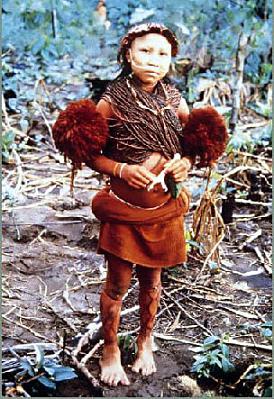
"In the early 1980s, petroleum exploration by the British-Dutch Shell Oil Company led to the first contact with the previously uncontacted Nahua tribe. Tragically, within several years more than half of the Nahua tribe had died. The Nahua people (also called the Yura, Yurahahua, or Yora)...."
The horses leaped out of the water, screaming with agony as the eels attached themselves to their bellies and discharged their electricity. They stormed up the banks, only to be forced back into the seething pool by the Indians’ harpoons . Within five minutes two horses had drowned, and the others at last succeeded in passing the Indians. The exhausted eels were easily taken with harpoons attached to the lengths of string, and were laid out on the bank for the scientists’ inspection.
“I do not remember” , wrote Humboldt, “ever having received from a discharge of a large Leyden jar a more dreadful shock than that which I experienced by imprudently placing both my feet on a gymnotus ( an eel ) just taken out of the water. I was affected the rest of the day with a violent pain in the knees, and in almost every joint.”
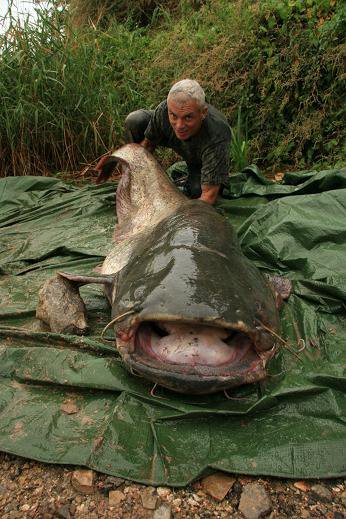
Jeremy Wade. Piraiba. "Wallace went up the Rio Negro, the Amazon's largest tributary (with a discharge four times that of the Mississippi), and its tributary the U aupes. There he glimpsed the fabulous cock of the rock-an umbrella bird with a crest stretching from the tip of the bill to the top of the head-and met some interesting Indians. In 1852, racked with fever and ague, he set sail for England, with a huge collection of specimens, dead and live. The ship caught fire and sank off the Guianas, and he lost everything. A lesser man would have been broken by the disaster, but Wallace wrote a beautiful poem about it, a brilliant book on the palms of the Amazon (almost entirely from memory), and a popular work, "A Narrative of Travels on the Amazon and Rio Negro," which occupies almost as highly respected a place in the literature of the Amazon as Bates's book. (Darwin, though, sniped in a letter to Bates, "I was a little disappointed in Wallace's book on the Amazon; hardly facts enough.") "
Undeterred by this accident, Humboldt “often tried, both insulated and uninsulated, to touch the fish, without feeling the least shock. When M. Bonpland held it by the head, or by the middle of the body, while I held it by the tail, and, standing on the moist ground, did not take each other’s hand, one of us received shocks while the other did not. …If two persons touch the belly of the fish with their fingers, at an inch distance, and press it simultaneously, sometimes one, sometimes the other will receive the shock. ”
By constant and varied provocation they established most of the characteristics of this deplorable creature, using insulators, joining hands while touching its head and tail, and prodding it with every sort of implement. The sight of tow learned men each holding one end of the Gymnotus ( eel) , one of them dancing in his convulsions and the other calmly taking notes, must have reduced the Indians to hysterical mirth, but when we remember that a fully grown eel can discharge as much as six hundred volts of electricity their perseverance becomes heroic.

"( Will )Crampton spent two weeks in the Raleighvallen National Nature Reserve, a wild area of rainforest, giant rivers, waterfalls and creeks teeming with wildlife. Eels there can grow to more than six feet long and generate more than 600 volts of electricity – so they require great caution during their capture and handling."
ADDENDUM:
Henry Walter Bates:We often read, in books of travels, of the silence and gloom of the Brazilian forests. They are realities, and the impression deepens on a longer acquaintance. The few sounds of birds are of that pensive or mysterious character which intensifies the feeling of solitude rather than imparts a sense of life and cheerfulness. Sometimes, in the midst of the stillness, a sudden yell or scream will startle one ; this comes from some defenceless fruit – eating animal, which is pounced upon by a tiger-cut or stealthy boa-constrictor.. Morning and evening the howling monkeys make a most fearful and harrowing noise, under which it is difficult to keep up one’s buoyancy of spirit. The feeling of inhospitable wildness which the forest is calculated to inspire is increased tenfold under this fearful uproar. Often, even in the still hours of midday, a sudden crash will be heard resounding far through the wilderness, as some great bough or entire tree falls to the ground. There are, besides, many sounds which it is impossible to account for.
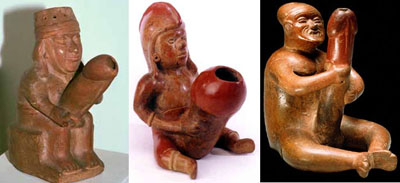
"The diversity of these warrior societies demonstrate several aspects of Sanday's thesis concerning the rise of patrarchy as a form of polarized response to ecological stress, including stresses caused by migrating warrior groups. They show in graphic detail how male dominance in warrior-hunter violence can lead to a break down of reproductive paradox, in which women are used as tradeable items or objects of rape, abduction and capture. Associated with these motifs are mythologies of primal sexual conflict and origins wrought in violence, migrational instability and conquest by war. The sexual relations reflect these mythologies, in polarization, sexual dominance and attempts by men to assert control over culture and the instruments of religious power by violence and fear. They also appear to have resulted in practices of female sexual mutilation, wife abduction and patterns of homosexual activity, which themselves have intimations of power and class and the rule of power of one individual over another, be they male or female."
“Humboldt was convinced that mechanical and chemical forces worked together in perfect harmony to sustain nature, but he wanted to identify those forces. He combined studies of magnetism, meteorology, ocean tides, zoology, botany, atmospheric chemistry, minerology, geology and topography. In one particularly ingenious set of experiments, he interspersed animal muscle tissue with metals and examined the muscle contractions produced by electrical currents. He then tested only nerve and muscle tissue, without any metals, and found they could also generate electrical currents. Humboldt concluded that electrical currents could have a source within living bodies, probably from the brain and nerves. Another of Humboldt’s experiments with electricity was more disturbing. To acquire electric eels for experimentation, he and some assistants herded about 30 horses into an eel-infested lake, trapping the horses there to be shocked repeately until the agitated eels exhausted themselves and posed little danger to the humans. Two agonized horses drowned in the first five minutes. They were vindicated somewhat when a not-quite-exhausted eel later shocked Humboldt. In fact, Humboldt willingly subjected his own body to painful electrical experiments, including gripping an eel in one hand and a piece of metal in the other to magnify the electric charge.”
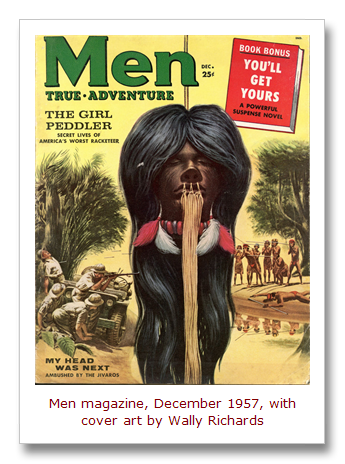
"It’s on the December 1957 issue of Men magazine, published by Zenith Publishing Corp., another publishing entity owned by the legendary founder of Magazine Management and Marvel Comics, Martin Goodman. And, yes, I really do mean this shrunken head cover art was done by a great artist. He’s credited as Wally Richards in the magazine. His full name is Walter DuBois Richards and he was a highly talented and respected American artist who died in 2006 at the age of 99."
——————–
“Amazonian Indian societies, including the Yanomamo and Jivaro provide an example of the extreme consequences of male domination and its ensuing tendency to conflict and violence. The death rates of Yanomamo men from warfare or homicide for example are 25-40% and Jivaros of 60%. By comparison with these figures !Kung rates of male homicide are as little as 0.3%. Although these societies are very different from modern urban cultures, they provide an insight into how male dominance leads to patterns of violence, polarization, instability and deprivation which have direct relevance to our own futures. .
[caption id=”attachment_24043″ align=”aligncenter” width=”350″ caption=”"There is among warrior societies a clear pattern supporting Joan Bamberger's thesis (R40) that warrior society depends on the myth of matriarchy a previous time in which women were in control which led to chaos, social strife and a rationalization for men to seize control from women. Bamberger notes two further examples which parallel the myth


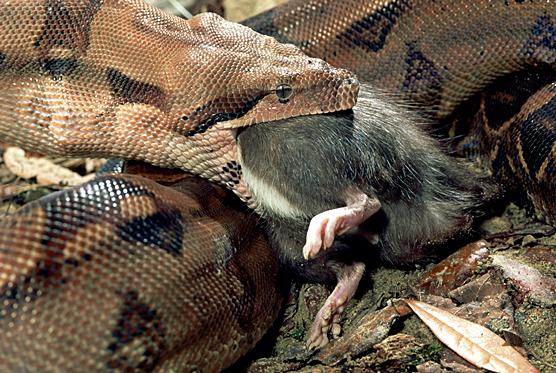



 COMMENTS
COMMENTS